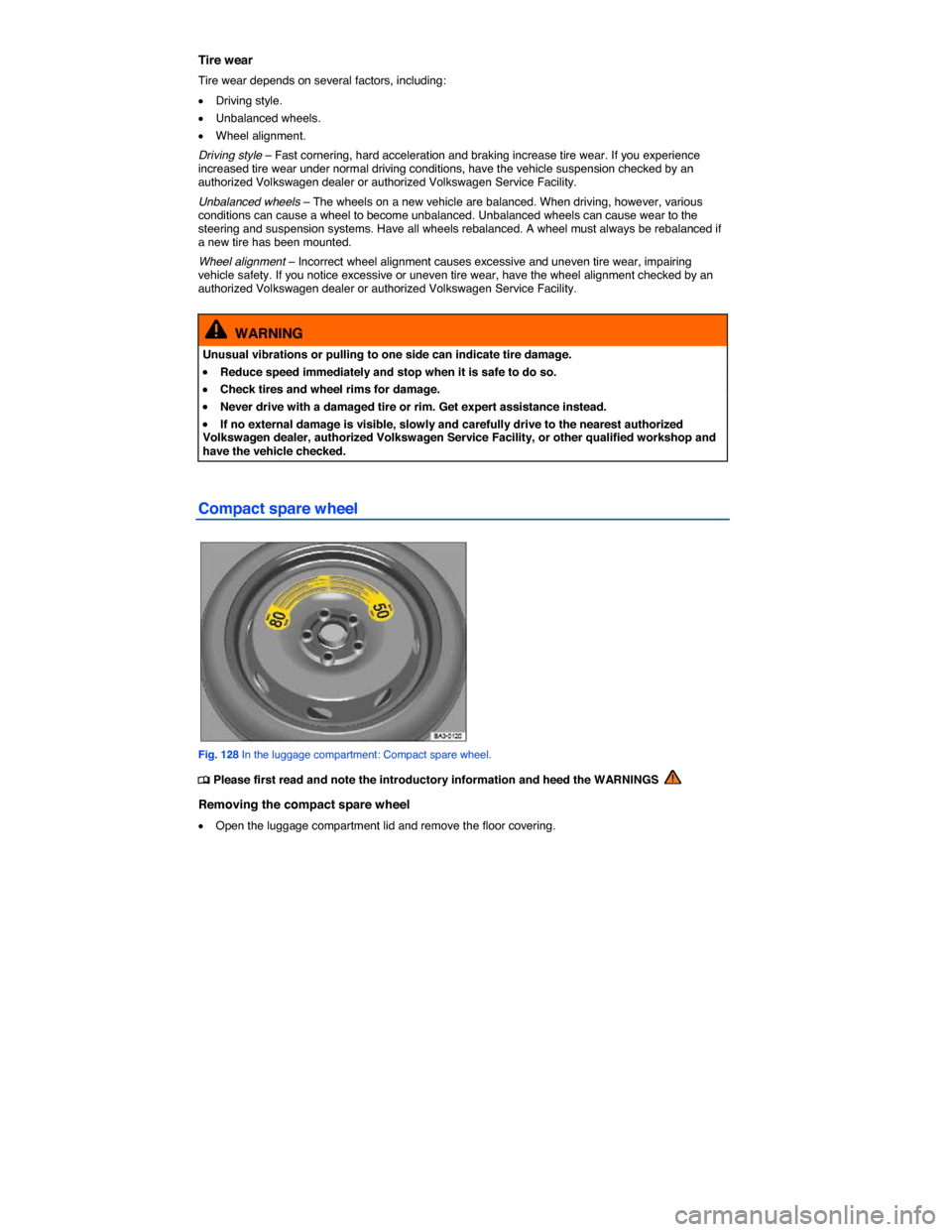2015 VOLKSWAGEN PASSAT spare
[x] Cancel search: sparePage 43 of 397

Vehicle identification label
The vehicle identification label ⇒ fig. 20 is affixed to the area of the spare wheel well underneath the luggage compartment floor panel and contains the following information:
(1) Vehicle identification number (VIN)
(2) Vehicle type, engine output, and transmission
(3) Engine and transmission identification codes, paint number, and interior type. In the example,
the engine identification code is “CBFA” ⇒ fig. 20.
(4) Optional equipment and part numbers
Safety Compliance Certification Label
A safety certificate affixed to the door jamb in the driver door confirms that at time of production all necessary safety standards and requirements of the traffic safety agency of the respective country were met. The month and year of production as well as the vehicle identification number may be listed as well.
Radiator fan and high voltage warning sticker
A warning sticker about the radiator fan and the high voltage of the electrical system is located in the engine compartment next to the engine hood release. The vehicle ignition system complies with the Canadian standard ICES-002.
Tire inflation pressure label
A tire inflation pressure label is on the driver door jamb ⇒ Tires and wheels.
Fuel grade sticker
An information sticker listing the correct fuel grade for your vehicle ⇒ Refueling.
Engine data
�
Page 81 of 397

Malfunction Possible cause Possible remedy
Garage door or electrical drive does not work.
Distance or transmission angle too great. Try different distances and angles to the receiver.
Garage door or electrical drive not compatible. May not comply with legal requirements and may have to be replaced.
Incorrect programming. Reprogram the garage door opener.
DANGER
20 mm button cells and other lithium batteries will cause serious personal injury and even death within a short time if swallowed.
�x Always keep hand-held remote control devices with batteries, spare batteries, as well as dead button cell and larger 20 mm batteries out of the reach of children.
�x Get medical attention immediately if you suspect that a battery has been swallowed.
WARNING
Improper use of the HomeLink® Universal Transmitter can cause serious or even fatal per-sonal injury.
�x Garage doors operate with enough force to cause serious personal injury.
�x Never let anyone get in the way of a garage door when it is opening or closing.
�x When programming the HomeLink® Universal Transmitter, you may be operating a garage door or estate gate. Always make sure that people and objects are out of the way to help prevent serious personal injury or property damage.
�x When operating the “training” button on a garage door opener with a rolling code, you will need to stand on a ladder or step-stool. Always take extra precautions to prevent falls and serious injury.
�x Never use the HomeLink® Universal Transmitter with any garage door opener that does not have the safety stop-and-reverse feature, as required by federal safety standards. This includes any garage door opener model manufactured before April 1, 1982.
�x A garage door opener that cannot detect an object, signaling the door to stop and reverse, does not meet current federal safety standards. Using a garage door opener without these features increases the risk of serious injury or death.
�x Follow the installation manual and the included safety information from the manufacturer when using the remote-controlled garage door opener or electrical drive.
NOTICE
The wrong batteries can damage the hand-held remote control. Replace a dead battery with one that has the same voltage, size, and specifications.
Please dispose of old batteries properly and in an environmentally responsible manner. Always keep them out of the reach of children.
Page 164 of 397

must replace or remount the tire as soon as possible in order to restore the correct direction of rota-tion.
Rotating tires
To help ensure even wear on all tires, regular tire rotation according to the diagram ⇒ fig. 122 is rec-ommended. In this way all tires can have about the same service life.
Volkswagen recommends that you have your tires rotated by an authorized Volkswagen dealer or authorized Volkswagen Service Facility.
Tires more than 6 years old
Tires age even if they are not being used. Physical and chemical processes reduce tire strength and performance and cause them to harden and become brittle. Old tires can fail suddenly and without warning.
Volkswagen recommends replacing tires that are 6 years and older. This also applies to tires that look new (including the tire on the compact spare wheel) or that seem to still be usable with tread depth
that has not yet reached the legal minimum depth ⇒ .
The age of each tire can be determined with the manufacturing date that is part of the U.S DOT tire
identification number (TIN) ⇒ Tire labeling.
Tire storage
Mark tires before removing them to help make sure that the previous location (left, right, front, rear) and rolling direction can be maintained when remounting them. Store tires in a cool, dry and preferably dark place. Do not store tires mounted on wheels standing up.
Tires not mounted on wheels should be covered to help protect them from dirt and stored vertically (sitting on the tread).
WARNING
Aggressive fluids and materials can cause visible and invisible tire damage that can cause tire blowouts.
�x Always keep chemicals, oils, grease, fuels, braking fluids and other aggressive substanc-es away from tires.
WARNING
Tires age even if they are not being used and can fail suddenly, especially at high speeds, causing loss of vehicle control, accidents, and severe personal injuries.
�x Tires that are more than 6 years old can be used only in an emergency and even then only with special care and at low speed.
Always dispose of old tires in accordance with legal requirements.
Wheel rims
�
Page 166 of 397

Replacing tires
�x Tires should be replaced in pairs and not individually (both front tires or both rear tires at the same
time) ⇒ .
�x Replace tires only with tires that have the same specifications, including width and diameter, load and top speed rating as the tires approved by Volkswagen for your vehicle and model.
�x Never use tires that are larger or wider than the dimensions of the tires approved by Volkswagen for your vehicle and model. Larger tires could scrape and rub on the vehicle body or other parts of the vehicle.
Tire Pressure Monitoring System (TPMS) considerations
The Tire Pressure Monitoring System must be recalibrated using the SET button whenever you re-move and remount or change any wheel or tire on the vehicle, even if the reinstalled or replacement wheels and tires are identical to those that were removed and even if the tire pressure does not
change. ⇒ Tire Pressure Monitoring System (TPMS).
WARNING
New tires tend to be slippery and must be broken in.
�x Always drive with special care for the first 350 miles (560 km) to help reduce the risk of losing control, a collision, and serious personal injuries.
WARNING
Tires must have the required clearance. Tires that do not have enough clearance can rub against parts of the vehicle body, suspension, and brake system, causing brake system fail-ure, tread delamination, and sudden blowouts.
�x Always make sure that new tires are not larger than the tires approved for your vehicle and that the new tires do not rub against parts of the vehicle.
NOTICE
�x When switching to different tires, make certain the valves are not damaged.
�x Never drive without valve stem caps. The valves could be damaged.
Always dispose of old tires in accordance with legal requirements.
If the replacement wheel is different from the tires that you have mounted on your vehicle (for example winter tires or wider, low-profile tires, or a compact spare), then use the replacement wheel for a short time only, and drive cautiously.
�x Replace it with a tire matching the others on your vehicle as soon as possible.
Although tire size specifications can be the same, the actual dimensions may differ from those nominal values for different tire makes, or the tire contours may be significantly different.
Page 169 of 397

Engine Tire dimensions Comfort tire pressure (full load) Standard tire pressure (full load)
PSI / kPa PSI / kPa
235/40 R 19 33 / 230 35 / 240
2.0 l / 150 hp (110 kW)
215/60 R 16 31 / 210 35 / 240
215/55 R 17 32 / 220 35 / 240
235/45 R 18 33 / 230 35 / 240
3.6 l / 280 hp (206 kW)
215/55 R 17 33 / 230 35 / 240
235/45 R 18 35 / 240 35 / 240
235/40 R 19 - 36 / 250
Compact spare wheel 135/90 R 16 - 60 / 420
The Tire Pressure Monitoring System is configured at the factory with the correct tire inflation pres-sure applicable for the vehicle model, engine and factory-installed tires. The tire inflation pressure is listed on the tire inflation pressure label on the driver door jamb. The tire inflation pressures for the road tires are listed on this label. The inflation pressure for the compact spare is as specified on the tire pressure label or on a separate label for the compact spare, if there is one. In the event of a discrepancy between the above figures and the tire pressures listed on the tire inflation pressure label, the pressures listed on the label are the ones you should use. The listed pressure applies to all road tires. The Tire Pressure Monitoring System must be recalibrated using the SET button whenev-er you remove and remount or change any wheel or tire on the vehicle, even if the reinstalled or replacement wheels and tires are identical to those that were removed and even if the tire pressure does not change
Tread depth and tread wear indicators
Fig. 126 Tread pattern: Wear indicator.
�
Page 171 of 397

Tire wear
Tire wear depends on several factors, including:
�x Driving style.
�x Unbalanced wheels.
�x Wheel alignment.
Driving style – Fast cornering, hard acceleration and braking increase tire wear. If you experience increased tire wear under normal driving conditions, have the vehicle suspension checked by an authorized Volkswagen dealer or authorized Volkswagen Service Facility.
Unbalanced wheels – The wheels on a new vehicle are balanced. When driving, however, various conditions can cause a wheel to become unbalanced. Unbalanced wheels can cause wear to the steering and suspension systems. Have all wheels rebalanced. A wheel must always be rebalanced if a new tire has been mounted.
Wheel alignment – Incorrect wheel alignment causes excessive and uneven tire wear, impairing vehicle safety. If you notice excessive or uneven tire wear, have the wheel alignment checked by an authorized Volkswagen dealer or authorized Volkswagen Service Facility.
WARNING
Unusual vibrations or pulling to one side can indicate tire damage.
�x Reduce speed immediately and stop when it is safe to do so.
�x Check tires and wheel rims for damage.
�x Never drive with a damaged tire or rim. Get expert assistance instead.
�x If no external damage is visible, slowly and carefully drive to the nearest authorized Volkswagen dealer, authorized Volkswagen Service Facility, or other qualified workshop and have the vehicle checked.
Compact spare wheel
Fig. 128 In the luggage compartment: Compact spare wheel.
�
Page 172 of 397

�x Completely unscrew the handwheel in the center of the compact spare wheel ⇒ fig. 128 counter-clockwise and remove the compact spare wheel.
Stowing the replaced wheel
�x Hook the floor covering on the upper edge of the luggage compartment.
�x Put the wheel you took off the vehicle into the spare wheel well so that the center hole of the rim is aligned with the threaded pin.
�x Turn the hand wheel clockwise until the wheel is securely in place.
�x If necessary, return the vehicle tool kit to its location in the luggage compartment.
�x Unhook the floor covering and fold it back down onto the floor of the luggage compartment.
�x Close the luggage compartment lid.
Differences between the road tires and the compact spare
The compact spare is different in design from the road tires and must be used only in the event of a
flat tire, only for a brief time, and only when driving with extra caution ⇒ .
Replace it with a tire matching the others on your vehicle as soon as possible.
Please heed the following:
�x Do not drive faster than 50 mph (80 km/h)!
�x Avoid full-throttle acceleration, hard braking and fast cornering!
�x Do not use snow chains on the compact spare wheel ⇒ Snow chains.
�x After installing the compact spare wheel, check the tire pressure as soon as possible ⇒ Tire infla-tion pressure.
Check the tire inflation pressure of the compact spare whenever you check the tire pressure of the road wheels, at least once a month. Inflate a compact spare wheel to the cold tire pressure specified for the compact spare on the tire pressure label or on a separate label for the compact spare, if there is one.
Page 173 of 397

WARNING
Improper use of a compact spare wheel can cause loss of vehicle control, a crash or other accident, and serious personal injury.
�x Never use a compact spare wheel if it is damaged or worn down to the wear indicators.
�x In some vehicles, the compact spare wheel is smaller than the original tire. A smaller compact spare wheel is identified with a sticker and the words “50 mph” or “80 km/h.” This is the maximum permissible speed when driving with this tire.
�x Never drive faster than 50 mph (80 km/h) with a compact spare wheel. Avoid full-throttle acceleration, heavy braking, and fast cornering!
�x Never drive more than 125 miles (200 km) if a compact spare wheel is installed on the front axle (drive axle).
�x Replace the compact spare with a normal wheel and tire as soon as possible. Compact spare tires are designed for brief use only.
�x Regularly check the U.S. DOT Tire Identification Number (TIN) to determine the age of the
compact spare wheel ⇒ Tire labeling. Tires age even if they are not being used and can fail suddenly, especially at higher speeds.
�x Tires that are more than 6 years old can only be used in an emergency and then with spe-cial care and at lower speeds.
�x The compact spare wheel must always be secured with the wheel bolts provided by the factory.
�x Never drive using more than one compact spare wheel.
�x After installing the compact spare wheel, the tire pressure must be checked as soon as
possible ⇒ Tire inflation pressure.
�x Snow chains cannot be used on the compact spare wheel. If you must use snow chains and have a compact spare wheel mounted, move the compact spare wheel to the rear axle if a front tire has to be replaced. The tire taken off the rear axle can then be used to replace the flat front tire. Be sure you do not change the tire's direction of rotation. Install the snow chains on the full-sized road tire.
NOTICE
When the spare wheel or compact spare is being used, the TPMS indicator light can come on after a couple of minutes.
If possible, attach the compact spare wheel or the tire you took off the vehicle securely in the luggage compartment.